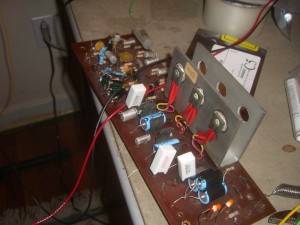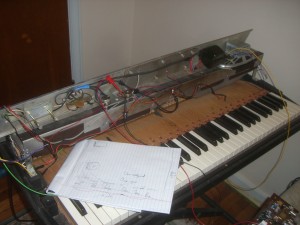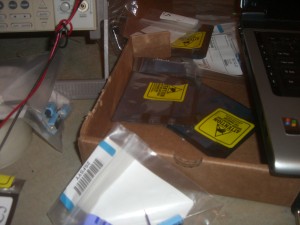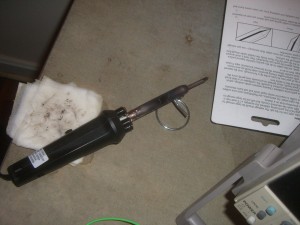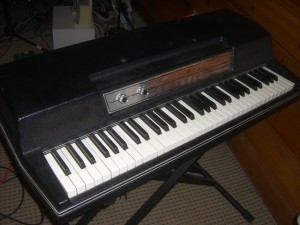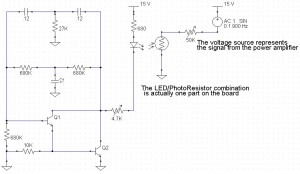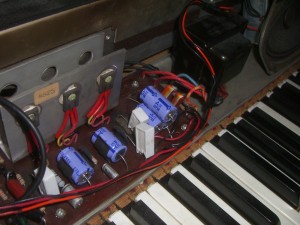Products today mostly use Printed Circuit Boards (or PCBs) to successfully route signals from one component in a circuit to the next. There are multiple layer circuit boards with printed metal “wires” that run between the various elements in a circuit. However, this was not always the case. In the good ol’ days, there were different variations and precursors to the PCB. Some of these included point to point wiring (just soldering a wire between say a resistor and a capacitor), wire wrap boards (think of a point-to-point board on a grid with more wires than you’d know what to do with), acid etched copper on dielectric (think of a 1 layer PCB with very large and rounded signal traces) and many others. These kinds of boards had many many different methods but also had less restrictions than modern designs. In fact, Paul Rako from EDN recently wrote a great article on prototyping using some of these older methods. He references many techniques of the greats like Bob Pease and Jim Williams and their rapid prototyping techniques. It’s an information rich article and I would highly suggest checking it out. OK, back to the party.
So what has changed when moving from older boards and circuit designs to newer circuit boards?
- Speed — There’ s no denying that the boards of today are faster than those of yesteryear. The extremes are apparent in the RF industry which is/was doing well because of the cell phone becoming the hottest platform to develop for (PCs are still around of course but the excitement is in the cell phone industry). When frequencies get into the GHz range and you’re trying to guide signals instead of wire them, you know that your boards will be finicky. Additionally, the speed increase is not limited to the RF industry as many new designs have at least some component of a clocked digital system on them. Even pushing into the MHz range can be difficult with older board techniques. Wiring point to point is not as viable with high speed signals, especially when you have upwards of 32 wires between two components (a data line).
- Size/Type of components – This is another symptom of newer industries. As products go increasingly mobile, parts begin to shrink out of necessity or because the cost of making the older, larger parts becomes prohibitive. As such, the boards have made a large change going from through-hole components (like the capacitors in the picture at the top of this site), to Surface Mount Technology. This has affected the construction of final boards (SMT usually requires machine placement for quick and reliable boards). This also means that the amount of power a board containing only SMT parts can absorb (when the board is considered as one entity) is reduced as the smaller SMT parts cannot handle as much current without blowing up.
- Number of connections — I’ve included a picture of wire wrap from the Wikimedia commons site below. Notice anything about it? It’s ridiculous! And I would encourage you to go to the Wikipedia page and look into some of the other types of wire wrapped boards. Now let’s look at a common package today, the Ball Grid Array (BGA). This type of package uses little solderballs on the bottom of the package to adhere to the board. It is glued on at first and when you reflow (heat up to make the solder melt), the balls fall into place on whatever PCB you have produced (assuming you have made the PCB correctly). BGAs start around 144 pins (maybe 196?) I believe and go to upwards of 1000 pins per part. Can you imagine trying to hook up 1000 wires like below? I don’t think so.
- RoHS — Lead is bad for the environment, for your health and for any children who decide to ingest it. In fact, the only people who speak the wonders of lead these days are cranky analog engineers such as myself, trying to solder something (I’m a 6 out of 10 on the cranky scale). Why do we love lead? Because Lead-Tin (Pb-Sn) solder is much easier to work with due to the lower melting temperature and higher thermal capacity. So as RoHS becomes more widespread, with the Silver-Tin (Ag-Sn) solder that is more difficult to work with, it become another element of board design that must change.
.jpg)
So obviously some stuff has changed. Some is for the better, some not so much. Let’s look at board problems encountered in modern day printed circuit boards in order to see the problems encountered as circuit boards have become more inexpensive and repeatably made:
- Capacitance in the board — Printed circuit boards are constructed from a non-conducting material so that signals do not leak from one lead to another. However, in constructing the perfect insulator, they also created a material with a significant (but not huge) dielectric constant. This means if two signals are routed over top of one another (acting like plates), then the sandwich of the signal and the dielectric will act like a capacitor. Not only that, but as you increase the frequency of a signal (with speeds upwards of GHz), the capacitor looks more and more like a shorted wire! This phenomenon is known as “cross-talk” and can affect myriad high-speed or high voltage situations.
- Inductance in the leads of a chip — Before the BGAs mentioned in point 3 above, there were packages (usually square) with leads coming out the sides known as Quad Flat Packs (QFPs). The leads coming out of them vary in thickness, but usually get thinner as there are more leads on a chip. As the leads get thinner and longer, the inductance of those leads goes up. We remember that inductors are the “opposite” of capacitors in that they allow low frequency signals to pass and block high frequency signals. In a system that is mostly high frequency signals (think digital), the inductance of the leads can have a serious affect on how well a signal propogates from one element on a circuit board to the next. BGAs have started to reduce this problem, but the cost of dealing with BGAs can be quite prohibitive for smaller operations.
- Timing — In a high speed system that requires signals to depart a component at a certain time and arrive at a different component a short (predictable) while later, there are many things that can prevent the signal from arriving undisturbed. We’ve already seen the capacitive and the inductive effects mentioned above, but what about resistance? Although everything has some amount of resistance, the lines in a board routing one component to the next can have an affect on the overall performance of a circuit. If one of these lines is longer than another than there will be a noticeable difference in the resistance of that line. Most importantly, when comparing the impedance (sum of the resistance and the frequency dependance of the impendance and capacitance) of two different lines going between components (say a processor and a RAM chip), differences can cause the signals to arrive at different times in different conditions. The rise times, the fall times, the over shoot, the under shoot, and the general shape of a signal can all be affected by the characterisitcs of the connection. It is useful to remember that every connection really acts like an RLC filter circuit, the only difference being how much resistance, inductance and capacitance are present and how they will affect the final signal.
- Ground/Power Plane — Other advantages a circuit board brings, especially multilayer circuit boards, is the ability to route a plane of power or a grounding plane underneath a portion of a design. If we think of a PCB as a large sandwich, the grounding plane would be like a slice of cheese, running underneath many of the different components of a circuit but not necessarily connected to them. If you design a circuit to have “vias” then an example component on the very top of a circuit board can connect down to the plane and access the power, ground or whatever signal happens to be running underneath there. This technique can be quite useful if you have many different op-amps in a certain area that will require positive and negative power supplies. Or if you have a large connector that requires a majority of pins to be grounded, a grounding plane can be useful to quickly connect many signals to the same net. However, as with any system, there are real-world consequences to deal with; in this case, we have to deal with electrons acting like electrons. With grounding planes, all of the pins on a board that are tied to ground will technically be at ground, however if one pin happens to have a large current going into the ground, then that area might have a slightly higher potential (voltage) than other ares of the grounding plane. This could have some definite effects in sensitive electronic situations and should be considered when designing a new PCB.
- Heat/Warping — A major downside to PCBs is the rigidity of the material; worse, when it heats up, it can often warp and become unusable. This could also be a problem in acid etched and wire wrap boards (the warping), but since the connections are often either larger traces or wires, the chances that the warping would break the connection are lower. Worse yet, the example above (dumping current into a ground plane) can create its own heat and warp a board without even being in a heated environment. Thermal budgets become important in any new PCB design and you should be mindful of them. Some SPICE programs even allow you to check out what the heat/power dissipation will be before putting the components on a board.
- Low Power — Unfortunately for high power circuit manufacturers, PCBs require extra care when they contain high voltages or high currents. Newer boards are often optimized for power savings, so high power situations are not as much of a priority for the tools that create PCBs. There are often constraints in the layout programs to ensure proper safety requirements, but other steps might be necessary, like separating high power lines from one another so they do not spark or create noise on other lower power lines.
Printed circuit boards allow for reliable products that can quickly be deployed to customers or used in a lab situation to test new circuit configurations. As long as you are mindful of the pitfalls of PCBs listed above, you can create circuit designs that can do just about anything imaginable. If you have any suggestions on how to create better PCBs or circuits in general, please leave your thoughts in the comments.
